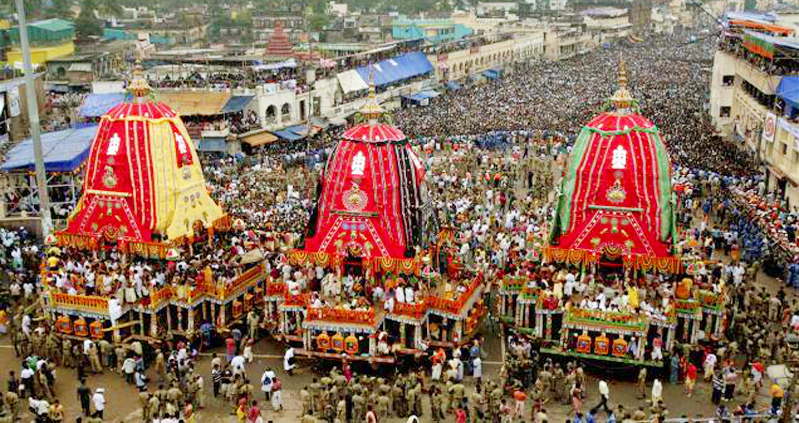Sudha Devi Nayak
You cannot miss the overarching presence of Lord Jagannath in every aspect of life in Odisha, never more so than this time of the year when it is Ratha Yatra and the Lord steps out of His abode with his siblings for a nine-day journey. It is a long journey, with a number of stops and rituals till he gets back triumphant to his temple. Lending a hand with pulling the chariots or having a Darshan among mindboggling crowds on the day is to enrich one’s life and frees oneself from the wheels of reincarnation and helps attain Nirvana. The greatness pilgrims experience here is manifested in everything that surrounds the Lord. The Lord is Bada Thakur (Great God); His temple is Bada Deula (Big Temple); the path in front of His temple is Bada Danda (Big Road); His prasad is Mahaprasad; and the sea that waits outside his temple is Mahadadhi (Big Sea) And this “grandness is reflected in the decorated, massive chariots and colourful ceremonial costumes He wears along with sister Subhadra and brother Balabhadra”. Everything contributes to the “Grand Design”.
Rath Yatra is flagged off by the Gajapati King who dons the outfit of a sweeper and with a gold handled broom cleans the road in front of the chariot and around it — a symbolic gesture that signifies that there is no difference between a powerful sovereign and a humble devotee so far as service is concerned.
The Yatra of the Gods is not without its controversies, owing to headstrong priests and unruly public, but the yatra continues on the tide of people’s faith and fervour. Parallel rituals of Ratha Yatra are performed across the country and on an international level with pomp and ceremony.
The huge chariots drawn during the Rath Yatra are etymological origin of the word ‘Juggernaut’. A despicable sense given to the word is crushingly destructive and mercilessly destroying opponents. In a figurative sense, the English word means something that demands blind devotion and selfless sacrifice. Nothing could be further from the truth. In Charlotte Bronte’s ‘Jane Eyre’ (1847) Jane is described as “worse than many a little heathen who says its prayers to Brahma and kneels before Juggernaut”. In Charles Dickens’s ‘Life and adventures of Martin Chuzzlewit’, the “Car of Juggernaut crushed him”. Mark Twain’s Autobiography-volume two, page 28, however, describes Jagannath as the kindest of Gods. Any pretension to rank and caste does not exist within His temple. Mark Twain got it right. It would be worthwhile to quote him: “I hold that God in most sincere admiration and reverence. He has always been misrepresented in Christian countries, if there is a better God anywhere I have not heard of him.
“All the movements of His spirit are kind, gentle, merciful, beautiful and lovable. His temple is full of pilgrims of all ranks from one end of India to another and when they step over the threshold of this temple, all caste, all nobility, all inequalities, all rank, station and wealth cease to exist for the time being — utterly cease and have no existence.
“The street sweeper and the sovereign prince, the outcaste, the mendicant and the millionaire all stand on one level, and may touch each other, and may eat the same dish and drink from the same cup without defilement. For the time being, those pilgrims constitute a perfect democracy, the only perfect democracy that has ever existed on Earth or ever will exist on it. It would improve other Gods to go to school to Juggernaut.”
He is invoked on all possible occasions of joy and sorrow, success and failure. His divine grace is extolled in thanksgiving for blessings bestowed as well as for resigned acceptance of one’s lot. Most of the time it results in a laid-back contentedness of a people who do not question or rail against an Almighty who they feel dispenses justice with an even hand. Every new beginning is with an incantation to the Lord, as is every end.
